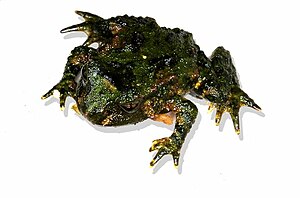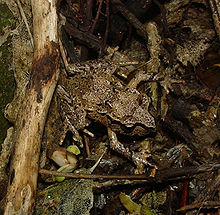New Zealand primeval frogs
| New Zealand primeval frogs | ||||||||||||
|---|---|---|---|---|---|---|---|---|---|---|---|---|

Leiopelma hochstetteri |
||||||||||||
| Systematics | ||||||||||||
|
||||||||||||
| Scientific name | ||||||||||||
| Leiopelmatidae | ||||||||||||
| Mivart , 1869 |
The New Zealand primeval frogs (Leiopelmatidae) are a family of frogs whose species are only found on the North Island of New Zealand or on small rocky islands off the South Island, such as Stephens Island (New Zealand) and Maud Island .
They are among the most primitive frogs in the world (compare: Archaeobatrachia ) and are so-called living fossils . The North American tail frogs (Ascaphidae), with which they have at least some anatomical similarities, such as nine vertebrae, are considered to be their closest recent relatives . Some authors therefore assign the two Ascaphus species directly to the family Leiopelmatidae.
Features and way of life
New Zealand primeval frogs are rather inconspicuous and relatively small frogs - representatives of species living today reach a maximum head-trunk length of 5 cm - with a broad head, round pupils, smooth to slightly warty skin on top and smooth-skinned soles of the feet. Unlike many other frogs, they cannot flick their tongues; instead, food animals are captured by pushing the body forward. When they swim, they do not use their hind legs at the same time (like most frogs), but alternately. New Zealand primeval frogs are nocturnal and the males do not utter mating calls. However, the animals can squeak when they feel threatened. In the case of the amplexus , the female is clamped in the lumbar region by the male. There is no aquatic tadpole stage , but a direct development of the eggs. The clutches are guarded by the adults. In two species ( Leiopelma archeyi and L. hamiltoni ) the hatchlings climb onto the back of the parent animals in order to complete their development there.
Taxonomy
Four species are recently known, which are grouped under the genus Leiopelma :
- Genus Leiopelma Fitzinger , 1861
- Species Leiopelma archeyi Turbott , 1942 - Archey frog
- Species Leiopelma hamiltoni McCulloch , 1919 - Hamilton frog
- Species Leiopelma hochstetteri Fitzinger , 1861 - Hochstetter frog
- Art Leiopelma pakeka Bell, Daugherty & Hay , 1998 - Maud Island Frog
In addition, there are numerous fossil finds from other islands around New Zealand. These long-extinct species include:
- Leiopelma markhami Worthy , 1987
- Leiopelma auroraensis Worthy , 1987
- Leiopelma waitomoensis Worthy , 1987
With a head-to-trunk length of 10 cm, the latter species was significantly larger than today's forms.
Background, danger
After only fifteen sightings of Leiopelma hamiltoni by 1964 , the German zoologists Eugen Schuhmacher and Helmuth Barth made a trip to Stephens Island. This is how the first film recordings were made (shown in the movie " The Last Paradises " from 1967) of these frogs, whose family already existed at the time of the dinosaurs.
The New Zealand primeval frogs are endangered or critically threatened with extinction, depending on the species, and have for the most part already been exterminated on the main islands by , among other things, introduced animal species . A fungal disease (see: chytridiomycosis ) is also made responsible for the decline of this (and many other amphibians worldwide). On Stephens Island, bridge lizards hunt the already severely weakened populations of primitive frogs, so their breeding grounds had to be protected by lizard-proof fences.
Other New Zealand amphibians
For today's amphibian fauna of New Zealand include not only the original native Leiopelma TYPES only three more, man-introduced species of frogs - to the Australian tree frogs belonging Litoria aurea , Litoria ewingii and Litoria raniformis . Two of them populate - in contrast to Leiopelma - also the entire South Island and Stewart Island .
swell
literature
- BJ Gill & AH Whitaker: New Zealand Frogs and Reptiles . Bateman, Auckland 1996.
- Chris Mattison: Frogs & Toads of the World . Blandford, London 1992. ISBN 0-7137-2355-6
- Eugen Schuhmacher: The last paradises - On the trail of rare animals . Bertelsmann GmbH, Gütersloh 1966.
Individual evidence
- ↑ List of amphibian species in New Zealand at Amphibiaweb
- ↑ Distribution map of Litoria aurea at www.iucnredlist.org
- ↑ Distribution map of Litoria ewingii at www.iucnredlist.org
- ↑ Distribution map of Litoria raniformis at www.iucnredlist.org
Web links
- Information and pictures at www.terranature.org (Engl.)
- Family Leiopelmatidae at Amphibiaweb (Engl.)
- "Amphibian Species of the World" (Engl.)
- Distribution map of Leiopelma archeyi at www.iucnredlist.org (IUCN hazard classification: "critically endangered")
- Distribution map of Leiopelma hamiltoni at www.iucnredlist.org (IUCN hazard classification: "endangered")
- Distribution map of Leiopelma hochstetteri at www.iucnredlist.org (IUCN hazard classification: "vulnerable")
- Distribution map of Leiopelma pakeka at www.iucnredlist.org (IUCN hazard classification: "vulnerable")




